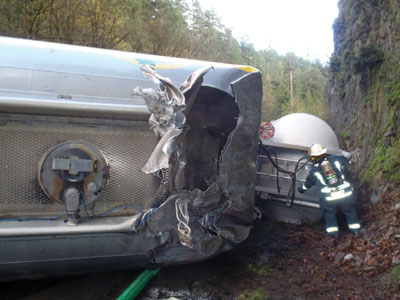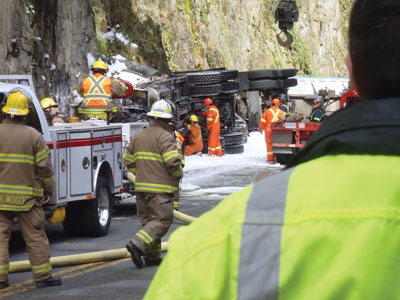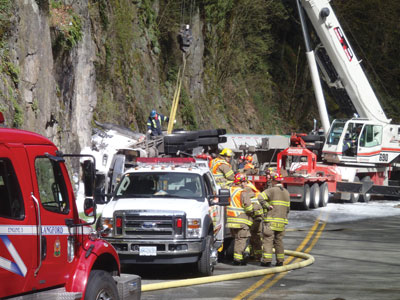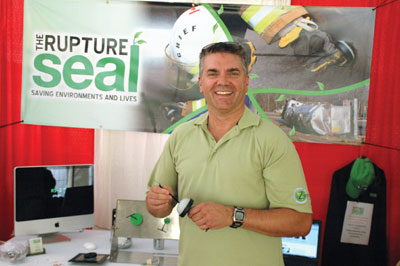
B.C. tanker crash challenges first responders
By Shannon Moneo
Features Hot Topics Incident ReportsEmergency responders in British Columbia can’t understand why 40,000 litres of gasoline and 600 litres of diesel didn’t erupt into flames after a truck pulling two tankers went off the road, overturned and spilled a majority of its contents.
Emergency responders in British Columbia can’t understand why 40,000 litres of gasoline and 600 litres of diesel didn’t erupt into flames after a truck pulling two tankers went off the road, overturned and spilled a majority of its contents.
 |
|
| The gaping hole in the tanker that overturned on B.C.’s Malahat Drive, near a river stocked with salmon fry. Photo courtesy Sooke Fire Rescue Service
|
What started around 1800hrs on April 16 on a stretch of the Trans-Canada Highway, just north of Victoria, B.C., known as the Malahat Drive, became a 22-hour roadblock when the driver of the fuel truck crashed his Columbia Fuels tanker. (The incident is under investigation. The driver was sent to Victoria General Hospital after the crash, where he was arrested for suspicion of impaired driving. The driver was also investigated for assaulting a police officer at the time of his arrest.)
“How it didn’t catch fire, no one can say,” says Kerry Zado, deputy fire chief with Langford Fire Rescue. Truckers who saw the incident told Zado that such fuel spills always ignite – just the spark from metal coming into contact with pavement will do the job.
“It was a 10 for its potential to be a cataclysmic event,” recalls Zado, who has been with the 60-member Langford department for 22 years, the last two years as deputy chief.
The crash occurred in Langford’s jurisdiction, and the department was on scene 10 minutes after a public 911 call came in. It quickly became evident that Langford would need to make use of its mutual-aid agreements. Colwood, another Victoria suburb that borders Langford, was called, as was Sooke, which doesn’t border Langford but is part of the Greater Victoria area.
Not only was Langford dealing with a fuel spill, but also it was obvious an environmental calamity was unfolding thanks to the location of the incident, which bordered a provincial park and the salmon-bearing Goldstream River.

|
|
| Responding crews from Langford, Colwood and Sooke used foam and sand to prevent further damage. Photo courtesy Sooke Fire Rescue Service |
Unfortunately, the truck’s fuel had quickly emptied into a ditch with a nearby culvert that went directly into the Goldstream River. The fuel expeditiously made its way into the river. Some of the fuel was also absorbed into the ground and fractured bedrock, and concerns remain about where the fuel will end up.
It took less than a minute for much of the gasoline to empty from the truck’s rear trailer, due to the big gash from the impact, says Fire Chief Steve Sorensen from Sooke Fire Rescue Service. And while the front trailer remained intact, diesel was slowly escaping from one of its compartments.
“It had tremendous potential to be really bad. But, it would have made cleanup easier,” Sorensen says.
If the fuel had caught fire, it would have started before any fire/rescue departments responded. In that case, the priority would have been protecting exposures and keeping the fire from moving through the trees in the non-residential and hard-to-navigate area without fire hydrants, Zado says.
Still, the reality on the ground was that the firefighters were dealing with not only a fire hazard, but also the contamination of a pristine stream and the long-term effects of gas entering into the environment, Zado notes.
To add insult to injury, the day before the spill, salmon fry had been released into Goldstream River as part of a fish-rearing project.
Meanwhile, the highway – the primary link connecting southern Vancouver Island to the rest of Vancouver Island – was closed. The corridor – a mix of two- and four-lane sections with speeds ranging from 50 to 90 kilometres per hour – is used by more than 20,000 vehicles each day.
 |
|
| The Malahat, over which 20,000 vehicles pass a day, was closed for 22 hours while responders dealt with environmental and safety concerns. Photo courtesy Sooke Fire Rescue Service
|
When Zado arrived, his first concern was safety. Because of the lay of the land – a highway full of curves and rapid changes in elevation – the normal 1,000-foot safety distance posed a challenge. “We had to mitigate the problem. How do you do that?” Zado recalls asking.
Foam was one solution.
Sooke was asked to bring its hazmat equipment, and the Colwood department, which had a foam trailer due to its proximity to Department of National Defence’s naval base, was asked to respond with the foam unit.
Within in about half an hour, Colwood had sprayed the foam to keep the gas vapour from igniting. Because of the location of the spill – hemmed in by a rock wall on one side and forested land on the other – there were no hydrants in the area, so water had to be trucked in to make the foam.
But even with the foam down, there was still a chance of an explosion as fumes travelled downstream on the river, Zado notes.
The local highway maintenance company, Mainroad South Island Contracting, brought in sand that was used to build berms to pre-empt any more fuel leaks since not all of the fuel initially spilled, Zado says.
When Sorensen and three other Sooke members arrived with their hazmat equipment, their first priority was to put a boom into the Goldstream River to absorb and contain the fuel. The river was also diked.
Sooke also did an initial assessment of the dangerous scene.
Sorensen, who ironically was recertified as a hazmat technician only the day before the incident, wondered what the odds were of being called on a hazmat incident. He was soon on his biggest hazmat call in 30 years of service.
In addition to the fire departments and Mainroad Contracting, the RCMP, ministries of transportation and environment, a hazmat team, traffic analysts, Columbia Fuels (the company that owned the truck) and a tow truck company were all eventually on scene.
“It looked like the lineup for the May Day parade,” Sorensen quipped. “At one point, there was probably a hundred people around.”
A decontamination area had to be set up. Because of the overpowering fumes, responders wore protective equipment and breathing apparatuses in the hot zone, Zado says. Fumes at the site were concentrated and not dissipating as quickly as hoped.
A lot of boots got washed and a few RCMP officers had to take time off work after prolonged exposure to the fumes, but there were no significant injuries suffered on site, Sorensen says.
It took the hazmat crew, hired by Columbia Fuels, about six hours to empty the fuel from the second tanker. A crane then picked up the wreckage for removal, only after much time was spent figuring out the best way to hoist and move the ruined mass. Firefighters also spent a lot of time holding hoses as a precaution while the tanker was being emptied, Sorensen notes.
According to the Ministry of Transportation, it was difficult to get the specialized equipment necessary to drain the truck’s tank. The potential for ignition of the fuel as well as an ongoing criminal investigation into the action of the truck’s driver also led to slowdowns.
There were several lessons learned from what became a 17-hour call for the Langford department.
Following an in-house, post-incident critique with other agencies, Zado says the No. 1 improvement would be to make sure all agencies on site can communicate with one another. When the tanker was being emptied, firefighters were not kept up to date on the progress because they couldn’t speak to those actually doing the job, Zado says. The communication shortcomings can be very easily rectified, he says. A unified command post should be set up at which someone from each agency is present so messages from each agency can be shared.
A second improvement would be tighter security at the scene to keep everyone safe, Zado says. Agencies need to know who is present. More accountability is needed.
But Zado is quick to note that, for the most part, everyone worked well together in what became – as Sorensen says – a case of hurry up and wait.
Now with two major fuel tanker incidents on his rap sheet (the first one a propane truck, also on the infamous Malahat), Zado doesn’t want a third.
Much is made of the dangers of driving the Malahat because it’s a road of many curves, but often crashes are due to excessive speed and driver inattention. A few decades ago, the day Zado got his driver’s licence, the neophyte hit the Malahat. “If you drive within your abilities and the speed limit, the Malahat’s not a danger,” he says.
Malahat Drive reopened at 1530hrs on April 17, almost a day after the fuel truck driver crashed his rig.
In late June, one area along the Goldstream River still carried the heavy odour of gasoline while fuel-absorbing booms floated on the surface.
| Plugging away at a solution to leaks Glenn Cox has a motto: Saving environments and lives. So it was difficult to miss his booth at the Maritime Fire Chiefs Association show in Fredericton, N.B., in July, where the mantra was splayed across banners promoting RUPTUREseal.
Cox knows of what he speaks. In 1994, he responded to a tanker truck accident on Vancouver Island, where he was stationed with the RCMP and was a volunteer firefighter. The tanker had overturned and was leaking diesel fuel from a two-inch gash. As Cox explained in Fredericton, the Department of Environment emergency-response team had been dispatched but estimated a three-hour response time. Cox had responded to the scene as a RCMP officer. The fire department arrived shortly thereafter but did not have equipment to stop the leak. When the emergency response team finally arrived, the spill specialist mixed a granular product with water and kneaded it until it turned into a putty. “He approached the leak with a small piece of plywood and a long-handled shovel,” Cox explains on the RUPTUREseal website. “As he was being sprayed by diesel fuel, he shoved the putty into the rupture and placed the plywood behind it. He then propped the shovel against it to hold it all in place, reducing the leak to a trickle. By then, several hundred gallons of fuel had leaked into the environment, costing thousands of dollars to clean up.” After leaving the police force, Cox worked as a risk manager for an insurance company. In 2007 he attended a seminar on hazardous spill site remediation, and it became clear to him that technology to plug leaks hadn’t advanced. Cox, who is a talented artist (he was a forensic artist for the RCMP), sketched an idea on a notebook for a RUPTUREseal. The RUPTUREseal is a four-foot, extendable device that uses a two-part polyurethane foam, which is injected into a specially designed bladder that is inserted into the rupture. Foam is injected into the bladder and seals the rupture in less than 15 seconds. This device is designed to seal leaks of two inches or more. In 2010, Cox developed a quick-plug device called the RS-2 to seal ruptures of two inches or smaller. Extensive research and development using a 1,000-gallon tank led to the creation of the prototype plug. (Neither product would have stemmed the flow of oil from the tanker on the Malahat in our story, but Cox says he continues to work on products to seal larger ruptures.) Both devices are meant to be temporary solutions but can last up to 10 hours. Fire departments can buy kits consisting of three plugs through the RUPTUREseal website at www.ruptureseal.com |
Shannon Moneo earned a bachelor of arts degree in journalism at the University of Regina. She is now a freelance writer based in Sooke, B.C. She avoids the Malahat Drive during rush hours and long weekends when some of the most aggressive, purely bad driving seems to rule the route.
Print this page
